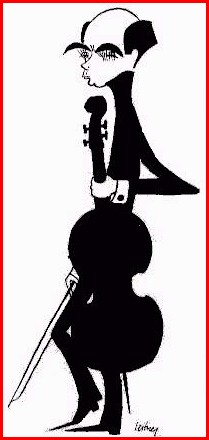Schwarz
View current page
...more recent posts
János Starker is one of the 20th century's greatest cellists. Hungarian born, Starker was a child prodigy touring Europe and the United States by the time he was 12 years old. Starker is a perfectionist and his tireless practice sessions are legendary. The man is a genius with his instrument. His technique is brilliant and his playing passionate.thx edo
These sessions were recorded in New York in the 1950's for the small label, Period. With no producer on hand, the musicians and engineers collaborated on the sound and mic placement. Starker himself helped in the editing process taking a razor blade to the session tapes. I guess that shows what can be done when you take the marketing people out of the creative process. As LP's these recordings were among those most prized by collectors. Sadly, they have been out of print for over 35 years. This is the first time they are available on CD.
This set is marvelous for its diversity, ranging from Boccherini and Mozart to Bartok and Kodaly is amazing.
I have to say that I usually dislike Bartok, but in Starker's hands Bartok becomes fascinating. If a musician can do that with Bartok, imagine how well the Mozart sounds!
We know the technique; but what’s the source of straw man? A poet in the 18th century responded to critical judgment with “Critics, who like the scarecrows stand/upon the poet’s common land.” The best guess about the trope’s origin is the farmer’s scarecrow — an old coat and hat set up on a pole and stuffed with straw to resemble a human sentry and frighten hungry blackbirds away from vegetable seedlings.
Though it appeared in a somewhat sexist 17th-century English saying — “A man of straw is worth a woman of gold” — in U.S. politics it was made famous in 1912 by President William Howard Taft, who had been set in place by the retiring Theodore Roosevelt four years earlier but who was being savaged by Teddy’s campaign to get his old job back: “I was a man of straw; but I have been a man of straw long enough. Every man who has blood in his body, and who has been misrepresented as I have . . . is forced to fight.” Taft won renomination, but Roosevelt ran as a “Bull Moose” independent, splitting Republicans and helping elect Woodrow Wilson, the Democrat.
Early in the 2008 primary season, The New York Post — not inclined to support most Democrats — surprised readers with the front-page headline “Post Endorses Obama.” David Carr, media reporter for The Times, asked rhetorically, “Why did The Post kick Senator Clinton to the curb?” While noting that the relationship between Rupert Murdoch of The Post and the Clintons was complicated, he wrote that the endorsement “invited suggestions that Mr. Murdoch was using The New York Post to set up a straw man for the Republicans to mow down in the fall.”
The noun phrase straw man, now used as a compound adjective as in “straw-man device, technique or issue,” was popularized in American culture by “The Wizard of Oz.” Dorothy (played by Judy Garland in the 1939 movie), backed up by the Tin Man (Jack Haley) and the Scarecrow (Ray Bolger), slaps the paw of the Cowardly Lion (Bert Lahr) for frightening her dog Toto and says, “It’s bad enough picking on a straw man, but when you go around picking on poor little dogs. . . .” The meaning is clear: a figure of a man stuffed with a cheap material may appear scary but is really weak and defenseless.
In the late 20th century, the metaphor was challenged by empty suit, but that was directed mainly at male business executives; as suits lose their fashion dominance, the old straw man endures both as a noun phrase and a compound adjective, scaring off flights of speechwriting fantasies.
mary hartman mary hartman
wiki torrent
Albers painted, for the most part, on untempered wood fibre-board panels, frequently masonite, although some of his earlier painted works are on other composition boards, and some are painted on aluminum. He also did a number of oils on blotting paper. He disliked canvas, as he felt it was too soft and absorbant. Instead, he favored the rigidity of the panels, where his painter's knife could glide smoothly over the surface maintaining a near-perfect, flat effect. Albers felt the rigid surface permitted the color to project more.thx joe c
These panels were carefully selected by Albers for their regularity. In the earlier paintings of the forties and fifties, Albers painted on the smooth side of the panels, priming them, as Doerner suggests, on both sides, to reduce warpage. Albers' grounds were always as white as possible to allow for the most luminous and pure painted surface. As time went on, Albers switched to painting on the rough side of the boards, for he felt that the paint adhered better and he could ultimately achieve a flatter, smoother surface. He no longer primed the reverse, as he discovered this led to the possible development of dry rot. Instead of in effect “sealing” the panel, he found he could reduce warpage equally effectively by merely rubbing linseed oil into the reverse.

